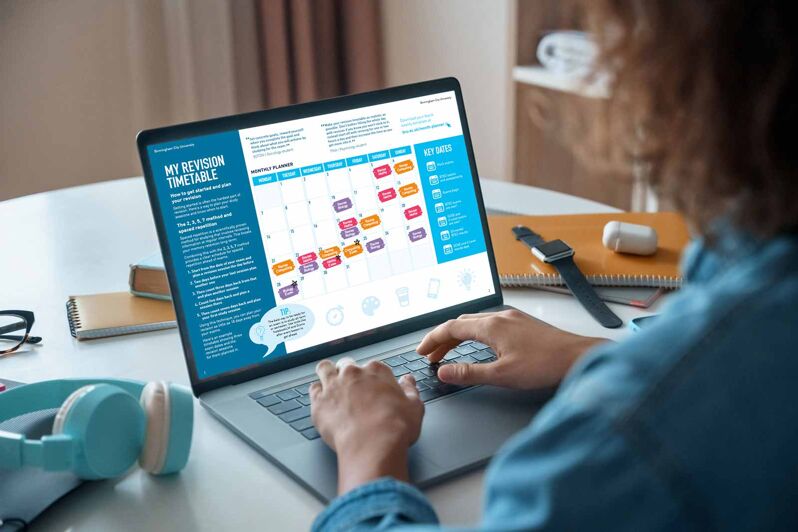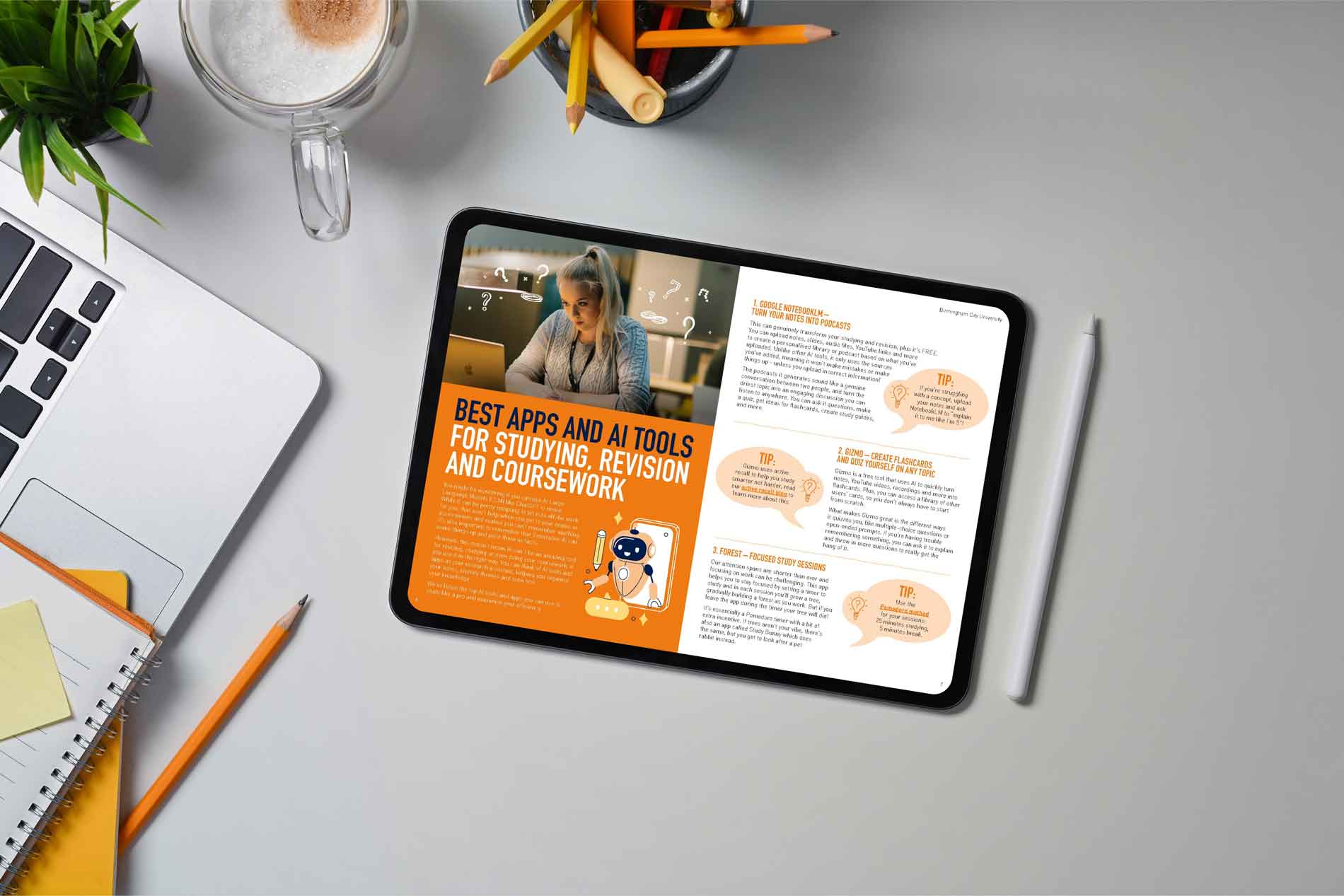0:01
Hi, I'm Charlotte and I am a marketing student at BCU. So, I got diagnosed with dyslexia when
0:08
I was still in primary school, I think I was around 10 years old and the three
0:12
biggest things that I noticed, my parents noticed, before I got diagnosed was that I
0:17
struggled to read large bits of text. I was watching all my friends read these really
0:21
big books and I was still on really small books with really large text. The second
0:26
thing was that I struggled to concentrate and write large bits of work, and then the
0:31
third thing was that my spelling was really bad and to be honest it's not any better today. So,
0:37
those are the three biggest things I noticed and then when I went to sixth form to do my A Levels
0:41
I got tested again and I got extra time on my exams which really helped me in that instance.
0:49
So, in terms of tips for helping you do coursework, revision, exams anything like that,
0:56
so firstly if you're having to read a lot, like if you're reading an article or something that's
1:02
you know quite a few pages, it can be really straining on the eyes and my mind so I like
1:07
to break it up into chunks. And then I also never just read it, you have to read and then make some
1:13
notes on it as well, because otherwise it just goes in one ear and then out the other, and yeah
1:18
I'll just never remember that way. Also, use as many colours as you can, highlighting it that
1:23
really helps me as well so I can visualise what's actually on the page. Secondly,
1:28
if I'm reading something and it's on a Word document I personally like to change the colour
1:34
of the Word document to black, and then change the text to white so it's sort of reversed and
1:40
that just helps me read it a lot better. You can get software for overlays which I know a lot of
1:47
dyslexic people use as well. I used to personally use a green overlay which used to help me,
1:51
but I'll tell you at the end of software you can use to put overlays on pieces of text
1:58
on your laptop or on your phone. The third thing that I would do is get a revision timetable or
2:05
a coursework timetable and actually stick to it. So you can actually see mine there,
2:10
I just need to be organised because what you want to do is avoid feeling stressed and anxious
2:15
about having a lot of reading or writing to do, you want to avoid that at all costs,
2:19
so if you just get a little bit done every day work towards it you'll avoid feeling horrible,
2:26
you know, towards the end when it comes to deadlines you don't want to feel that way at all.
2:32
The first thing that I would do is proofread your work before you submit it, get somebody else to
2:39
read your work before you submit it, use things like spell check or Grammarly on your laptop, just
2:48
anything you can to prevent any spelling mistakes. It definitely helps to have somebody else read it
2:53
because you know you might have spelled the word right but it might be the wrong word
2:57
and spell check isn't going to pick that up, so that's something to remember. Before you actually
3:01
start writing your coursework, I would again when you're reading something take notes and highlight
3:08
lots of different colours is the best thing for me. Also, I'm not a huge fan of silence when
3:14
I'm doing coursework or you know something a bit creative that's not just dedicated essay writing,
3:18
but I can't listen to any music that's got words in because I will hum or sing along
3:23
in my head so I have to listen to something without words like classical music or you
3:27
can find study playlists which you know just piano or it's no one singing. So,
3:32
I really find that helps occupy my mind so it's not so silent when I'm trying to do work and that
3:38
makes me get distracted. If you're doing research on a topic or you're struggling to understand the
3:42
theory or concept I would definitely recommend watching some videos or documentaries on it,
3:46
and that will just give you a starting point and then you can go off and do your reading and you
3:51
know reference that on your work. But, visual things again are so much easier to understand
3:56
than large bits of text for me so utilising any documentaries or videos is something that is just
4:04
really helpful. Another thing similar to doing your notes before the lectures. I would definitely
4:10
start your assignments as early as possible, this will not only give you chance to speak to your
4:16
tutors as early as possible, and hopefully give you multiple chances to speak to them throughout
4:21
when you're doing your assessments, it will also just help you feel a lot more prepared you have a
4:27
lot more time to do your work and again you just don't want to feel anxious when you get to that
4:31
deadline day, so starting early as possible is the best possible thing that you can do.
4:38
In terms of like revision methods, one of the big things that helped me during my A Levels was cue
4:45
cards I always like to say things out loud because that just helps me remember them instead of just
4:51
reading it, because it just, like I said, it goes completely over my head so practicing
4:54
with your friends and family that really helps as well. Yeah just saying things out loud is
5:01
the best thing to do for me, also with cue cards you're putting things in concise bits of writing
5:07
you know you're not having to remember really large bits of text, which to be honest I don't
5:11
know who can do that anyway, so making sure your notes are concise, they're visual you're using
5:18
colours of different cue cards to categorise you know topics or subjects, that really helps
5:23
as well because you associate that colour with the topic and then you remember what's on the
5:26
cue card. The second thing is having multiple methods of revision for example I like to make
5:34
posters I like to do like visual creative things and that helps remember them, so you know putting
5:41
pictures next to keywords that's something that I find really helpful and then like I said I'll do
5:46
the cue cards, I also do past papers because you know you have to be realistic about it if you're
5:50
doing exams you have to know what you're writing, but like I said before you're trying to avoid
5:54
feeling stressed and anxious on the day or on the deadline so doing things like that beforehand
6:00
are just really helpful. Another thing that I would do is when you come to University a
6:06
lot of your lecture notes will be put on a site called Moodle where you can see all of them before
6:12
or after the lesson, so personally what I like to do, I like to look at the notes
6:17
before the lesson do all of the notes, so you know write everything that's on the PowerPoint
6:21
and then within the lesson you're actually able to concentrate and take in what your teacher's saying
6:26
instead of panicking and writing all the notes down within the one or two hours that you have,
6:29
so that's another thing that I would do just be prepared before your lessons.
6:38
If you think that you might have dyslexia, there are a number of things you can do before coming to
6:44
University. So, you can speak to the Student Support advisors or the Disability Team and
6:49
they'll be able to screen you to do a test to see if you have dyslexia, and this can lead to things
6:55
like you know extra time on your exams or special exam arrangements and you get extra time on your
7:01
coursework, and you might have extra support from your tutors, so you've really got nothing to lose
7:06
by speaking to the Disability Team to see if they can help you out during your University journey.
7:14
In terms of apps that will help you with dyslexia in University or you
7:20
know whenever you're doing your exams like I said Grammarly is really helpful,
7:26
it basically brings up any spelling or grammar mistakes that spell check not always brings up
7:31
it's a lot more advanced and you can download that onto your laptop and use it on things like Word
7:36
when you're writing out coursework or essays. Secondly, there is a
7:40
platform called ColorVeil which, like I mentioned before, is an overlay software
7:45
where you can you know put different colours over your reading and then that will help you
7:51
read it a bit better, and you can also choose from like so many different colours on it and
7:55
you can also change the opacity which a lot of softwares don't allow you to do.
8:01
A bit of final advice, like I said speak to the Support team at Uni they are more
8:07
than willing to help you out. Also, there is a Neurodivergent Society at BCU so if
8:11
you want to speak to people who you know understand your situation or you want to
8:15
ask them any questions they'll be really open to you know inviting you in and answering any
8:21
questions that you possibly have. I really hope this video helps and good luck ,bye.


